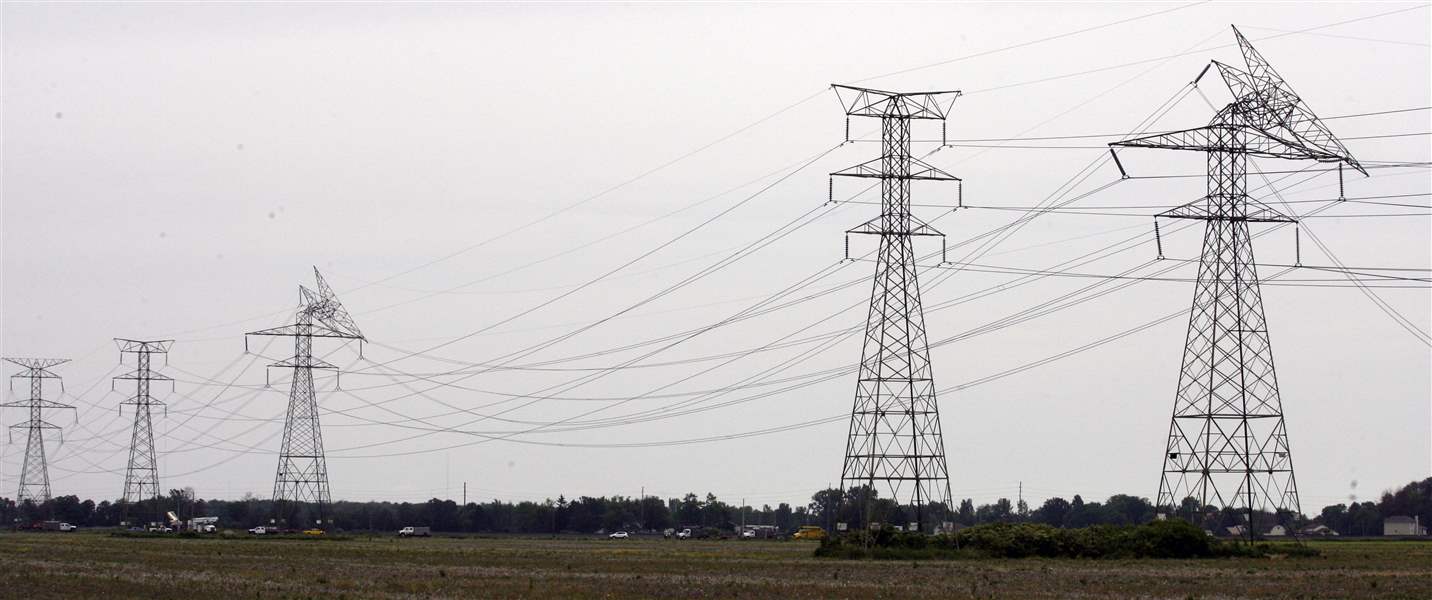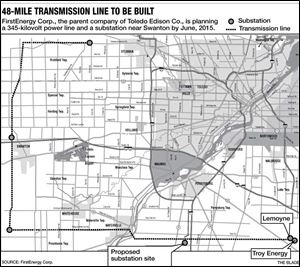
New high-voltage line planned
FirstEnergy cites reliability, contingencies
10/4/2013
The Blade/Jeremy Wadsworth
Buy This Image
Editor's note: This version of the story contains a corrected map of the planned 48-mile power line.

A subsidiary of FirstEnergy Corp. plans to spend $44 million to string a 48-mile high voltage power line through four counties in northwest Ohio, plus add a substation in northern Wood County, all by mid-2015.
The line and substation, along with a $12 million substation recently completed near Swanton in Fulton County, are needed to ensure that FirstEnergy’s power grid in northwest Ohio doesn’t become overtaxed and vulnerable to failures three years from now.
FirstEnergy will build the substation while its subsidiary, American Transmission System Inc., will construct the power line.
“It’s all about contingencies and to make sure our contingency plans are in place. … We need to ensure the reliability of the system,” said Mark Durbin, a spokesman for FirstEnergy, the parent company of Toledo Edison.
The new 345-kilovolt power line and two substations became necessary after FirstEnergy decided to shut three coal-fired generators at its Bay Shore Power Plant in Oregon, and also close three coal-fired plants in northeast Ohio — the Eastlake Plant, the Ashtabula Plant, and the Lake Shore Plant in Cleveland. The three Bay Shore units closed last year. The northeast Ohio plants will close in 2015.
The utility decided to close the old plants because it did not want to install expensive new pollution controls to meet the U.S. Environmental Protection Agency’s new restrictions on emissions of mercury and other toxic metals. The standards take effect in 2014, or with an EPA-approved extension, in 2015.
PJM Interconnection, the grid operator for the eastern United States, including Ohio, analyzed FirstEnergy’s shutdown plan and determined that shutting down the plants could create a number of potentially risky factors.
Losing the three Cleveland-area plants means less power emanating from that area, causing electricity in Toledo Edison territory to tend to flow east to make up for the drop in power there.
Power demand in northwest Ohio, which a has a high-end user in North Star Bluescope Steel in Delta in Fulton County, is expected to grow by 1.5 percent annually over the next three years.
In times of peak demand, power in the region could be augmented by Bay Shore’s four generators. But with only one Bay Shore generator — it burns pet coke supplied by the nearby BP-Husky refinery — now available, that won’t be enough to meet demand. Power would have to be sent to northwest Ohio from outside the region along high-voltage lines.
Only one such line now serves Lucas, Fulton, Wood, and Henry counties and PJM feared that if that line overheated, was damaged by a tornado, or suffered some other problem, power to the region could be lost.
Adding the 345-kilovolt line, to be called the Fulton-Lemoyne line, will alleviate the problem, PJM said. The substations will boost or reduce the power along the line as needed.
The 48 miles of new line, which will cost $23 million, will mostly be added to transmission towers now in place, Mr. Durbin said. Eight more towers will be constructed on the route.
One end of the line will start at the Troy Energy gas-fired power plant in Lemoyne in Wood County. It will travel west into Henry County, then head north through Fulton County and end up in Sylvania Township in western Lucas County. The high-voltage line and proposed substation, to be in Middleton Township and cost $21 million, are expected to be operational by June 1, 2015, FirstEnergy said.
The project needs approval by the Ohio Power Siting Board. The utility will be allowed to recoup the $44 million cost from its customers because the project is necessary to maintain grid reliability under directives from the North American Electric Reliability Corp., which receives its authority from the Federal Energy Regulatory Commission.
Contact Jon Chavez at: jchavez@theblade.com or 419-724-6128.